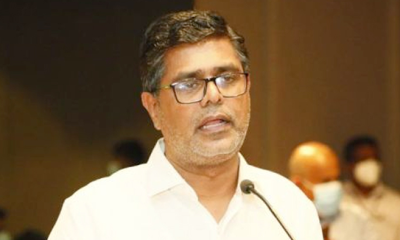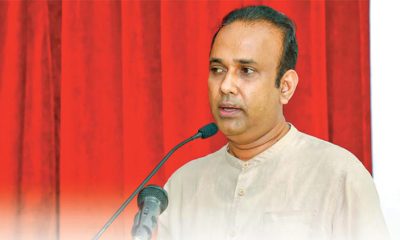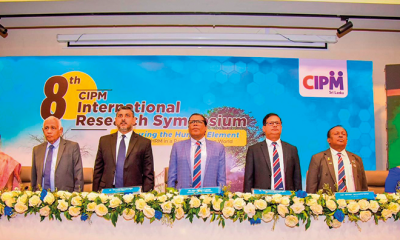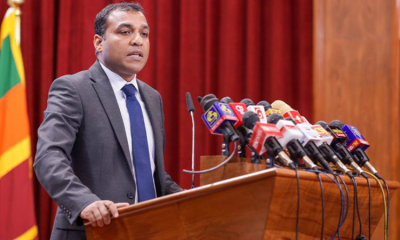Features
Perfect way to look younger as you get older

By Dr Indrajith P. Hathuruisngha
At present, people are keener on their appearance than ever before. Irrespective of gender, age, occupation, social status, everyone wants to look attractive, younger or handsome, and this has become more manifest with the advent of social media. The real challenge, however, is for you to look younger as you grow old. Ageing is something that we cannot prevent because it is a natural phenomenon. Weight gain becomes a concern as you reach middle age and this is more prominent, especially around your belly area. This is also known as the middle-age spread. This will make you look somewhat older, or unappealing, and even may extend to obesity, leading to certain health problems. It is a much-discussed issue, but the real question is whether it is being addressed scientifically. If you know how it happens or what causes it then it would be easier to control or tackle it. Some areas to focus on in terms of maintaining your figure that will eventually lead to a healthier and happier life in the long term, will be discussed here.
Our body needs energy to sustain life, and its operating mechanism is almost like that of a moving vehicle. The vehicle meets its energy requirements by burning fuel, and our body does the same thing with food on a daily basis. Our food contains a lot of nutrients such as protein, fat (lipid), carbohydrate, minerals and vitamins. They provide us with energy in terms of calories. If our daily calorie intake exceeds the demand, the additional amount will be stored in our body leading to weight gain. Fat is known to be the component mostly responsible for unwanted weight gain. If you can remove already existing fat in the body and also regulate further addition, you may be able to control it to a certain extent.
Fat is metabolically broken down to generate energy in our body. This is biologically called ‘lipid turnover’ and this process has been proven with C14 (a radioactive carbon) by scientists. The lipid turnover is about the capacity for storing or removing fat from our body and it happens in fat cells in the adipose tissue. Whether you are gaining weight or not, your lipid turnover rate in fat tissue will lower with age. You are therefore more likely to gain weight as you get older. In other words, weight gain is not prominent in younger people due to their higher rate of lipid turnover. It is also seemingly independent of other biological processes in our body. However, the particular concern is whether we can do something about it. We certainly can. But it is not easy, it would mean going against nature.
We cannot consider increasing the lipid turnover alone, as it is linked to other aspects such as food intake and physical exercises. Therefore, a well thought-through plan and a strong dedication is a must for achieving the desired outcomes. Here are a few ways to lose weight sensibly.
Types of exercises
Scientists have found that physical exercise is one of the ways of increasing lipid turnover. But the problem here is, what sort of exercise should one do? People often complain about not gleaning expected results even after intense exercise over a prolonged time. And most cannot find time to work out due to their busy schedule. If you are unable to exercise regularly you can engage in incidental activities such as walking or using the stairs instead of the lift. Exercising does not mean weight loss alone, as it has many other benefits.
You can start your workout in a more structured way, with aerobic exercises, such as cycling, running, swimming and hiking. Recent studies have shown that walking for extended periods is a good way to burn fat and you need to do it continuously for better results. It helps stimulate both heart function and breathing and improves the pumping of oxygenated blood to muscles. Muscles require enough oxygen to burn calories and to generate the required energy for smooth functioning of body. This type of exercise entails many benefits, such as better cardiovascular function, muscle fitness, bone and joint fitness, heart and lungs health. Eventually, it will improve the overall level of fitness and reduce chances of cancer, diabeties, cardiovascular disease and osteoporosis.
On the other hand, resistance exercises play a major role, than aerobic exercises, in weight loss. Lifting weights is more efficient as it helps to burn fat fast. Therefore, doing both these types of exercises in conjunction will be more beneficial. Apart from improving physical fitness, exercise also improves your mental health.
Food intake
Sometimes, it is difficult to control weight gain by exercise alone. The control of food intake is another way of losing weight. But you need to do it wisely. Eating delicious food is an enjoyable experience. Consequently, changing eating patterns is not that easy and needs to be done systematically. You will lose weight if you reduce food intake drastically. But it is not a good move in the long run and will also not be sustainable. The food is the source of energy for your daily routine. If you do not get the adequate calories, you will be easily fatigued, tired and perhaps end up with some nasty side effects. Therefore, having a balanced diet is of paramount importance to a healthy life. Besides, you must be physically fit to be able to exercise regularly.
You may find it difficult to change your food intake at the beginning but it needs to be continued for better results. You need to set goals in your weight loss endeavour. Maintaining a food diary is a good way to start, but you need to be honest about it. You are required to write down everything you eat irrespective of the situation, what, where, when and with whom you ate. The food diary helps you cut down the discretionary calories (optional foods and drinks). However, it is all about your commitment and dedication. If you are too concerned about your weight, it is advisable to consult a doctor or dietician before changing your eating habits. It is worth noting that processed food, surgery drinks, and alcohol must be avoided.
It must be emphasised that if food intake is to be reduced, it should be done sensibly, since you might lose certain important nutrients that are required to maintain a healthy life.
Re-gaining weight once exercise stops
When you lose weight by controlling food intake, your metabolism slows down automatically. Then the brain stimulates hunger, making you want to eat more to gain the required energy. Scientists have found that our body has remarkable resistance against weight loss but not for weight gain. This has become an intriguing point of interest among the people who want to shed a few extra kilos. According to another scientific revelation, weight is regained particularly as fat mass and not in lean mass. This finding has discouraged many who work towards sustainable weight loss. However, there is no clear cut explanation and more research is being done to understand the science behind it.
In general, you could either eat less and exercise less or eat more and exercise more. Whichever the method you apply, the one you should remember is that food intake is more important of your weight loss regime and it is about incorporating physical activity with food intake.
Types of food to eat
People often worry about what to eat and avoid. Your food should have three main characteristics; low in calories, promotes fat burning and slow in digestion. When you feel hungry, you tend to eat more. But if you can suppress your hunger, you can reduce your food intake. Therefore, you must select the food that keeps you full longer. In other words, the foods which slow down the metabolism and control your appetite. What are these food; those food with a high level of fibre, contain water or are rich in protein. Beans, chickpeas, lentils, eggs, nut and oatmeal are highly recommended. It is always good to add some grains to your breakfast as they are rich in fibre. Our nation is blessed with a variety of green vegetables, fruits, meat, fish and grains.
You must also stick to healthy food and stay away from fast or junk food. Always choose food rich in fibre, antioxidants, vitamins and nutrients. There are plenty of options for affordable meals. Expensive food should not be resorted to in the weight loss plan. Our staple food is rice, same as most other Asian countries. But you must choose brown rice instead of white rice. This is because brown rice is low in calories and contains important elements such as phytonutrients, fibre and starch.
Adding green vegetables to the diet as much as possible is a good move. For instance, cabbages, low in calorie, contain antioxidants and vitamin C. Similarly, cauliflower is a very low-calorie option and has vitamins such as C, K, and B6. Moreover, cauliflower and carrot have calorie burning properties.
Bananas help keep full longer and put you on fat-burning mode. You must not forget to add fruits and nuts to your main meal. Apple, orange, avocado and almonds are rich in antioxidants, vitamin C and fibre. This will help shrink your waistline and keep your hunger at bay longer. It is best to add yoghurt or curd as a dessert to your main meal, because yoghurt and curd are packed with protein and will help you feel full for longer. These are just a few examples out of many affordable options available and you have to be wise enough to choose healthy food for your daily intake.
If overweight
The Body Mass Index (BMI) is a good indicator to assess your condition for the weight loss plan. It indicates the ideal weight of an average person based on height. A general physician or a family doctor can easily tell you your BMI value or you can do it by yourself if you are familiar with the index.
According to the World Health Organisation’s (WHO) classification, people with an IBM value between 25.5 and 29.9 fall into the overweight category. If this value is above 30, it is considered obese and immediate doctor or dietician consultation is recommended. They will advise you how to control your food intake systematically. The BMI of a healthy person is usually 18.5 to 24.9 and should not drop below the minimum threshold. It must be emphasised that the purpose of eating is to sustain life and should not be driven by gluttony. Therefore, you must avoid taking additional calories. It is all about self-control.
If the situation is irreversible, one can still opt for bariatric surgeries. These types of surgeries are varied and the doctor decides what sort of surgery is suitable for each individual. Bariatric surgeries involve removal or shortening of a part of the stomach, with gastric bands, by altering the path of the intestine. However, there are pros and cons of such surgeries, and therefore, must be considered the last resort. You must be in charge of your own health before things get out of hand.
Advertisements and weight loss
Weight loss seems to be a good marketing tool, with various advertisements attempting to coax consumers to buy certain products. For instance, some advertisements showcase a pretty athletic woman drinking tea, claiming that she got her athletic figure by drinking a special kind of tea. Do you think that they have a secret recipe for weight loss? They don’t, but they know what you want and the demand in the market. The science behind this is simple. Because tea, particularly green tea has fat-burning properties. Apart from that scientists have found that green tea is full of antioxidants, has the potential to fight against inflammation, improve metabolism, boost energy, and refresh your body. Therefore, drinking green tea, instead of opting for advertised products, is a healthy and smart choice.
Non-fat milk or milk powder advertisements are another fad. We all know that milk is a good source of nutrients but fat is the killer. In general, mammalians, including humans need milk during infancy but not in adulthood. You may drink fresh milk if required but not milk powder. This is because vital nutrients are removed during the processing of milk powder and you are forced to drink a product which is low in nutrients. However, manufactures have different formulas to please consumers. Eventually, you get very little in return, but hoodwinked by misleading advertisements, spend hard-earned money.
The most important aspect of weight loss is the lipid turnover rate in the body. People often overlook it or do not have a grasp on the scientific facts. Weight loss maybe short term and you need to know how to make it sustainable. A combination of aerobic and resistance exercises offers a lot of health benefits and can help achieve sustainable weight loss, if undertaken in conjunction with food intake control.
(The writer is a lecturer at the Department of Applied and Environmental Chemistry, CRTAFE, Geraldton Campus, Western Australia.)
Features
The heart-friendly health minister

by Dr Gotabhya Ranasinghe
Senior Consultant Cardiologist
National Hospital Sri Lanka
When we sought a meeting with Hon Dr. Ramesh Pathirana, Minister of Health, he graciously cleared his busy schedule to accommodate us. Renowned for his attentive listening and deep understanding, Minister Pathirana is dedicated to advancing the health sector. His openness and transparency exemplify the qualities of an exemplary politician and minister.
Dr. Palitha Mahipala, the current Health Secretary, demonstrates both commendable enthusiasm and unwavering support. This combination of attributes makes him a highly compatible colleague for the esteemed Minister of Health.
Our discussion centered on a project that has been in the works for the past 30 years, one that no other minister had managed to advance.
Minister Pathirana, however, recognized the project’s significance and its potential to revolutionize care for heart patients.
The project involves the construction of a state-of-the-art facility at the premises of the National Hospital Colombo. The project’s location within the premises of the National Hospital underscores its importance and relevance to the healthcare infrastructure of the nation.
This facility will include a cardiology building and a tertiary care center, equipped with the latest technology to handle and treat all types of heart-related conditions and surgeries.
Securing funding was a major milestone for this initiative. Minister Pathirana successfully obtained approval for a $40 billion loan from the Asian Development Bank. With the funding in place, the foundation stone is scheduled to be laid in September this year, and construction will begin in January 2025.
This project guarantees a consistent and uninterrupted supply of stents and related medications for heart patients. As a result, patients will have timely access to essential medical supplies during their treatment and recovery. By securing these critical resources, the project aims to enhance patient outcomes, minimize treatment delays, and maintain the highest standards of cardiac care.
Upon its fruition, this monumental building will serve as a beacon of hope and healing, symbolizing the unwavering dedication to improving patient outcomes and fostering a healthier society.We anticipate a future marked by significant progress and positive outcomes in Sri Lanka’s cardiovascular treatment landscape within the foreseeable timeframe.
Features
A LOVING TRIBUTE TO JESUIT FR. ALOYSIUS PIERIS ON HIS 90th BIRTHDAY

by Fr. Emmanuel Fernando, OMI
Jesuit Fr. Aloysius Pieris (affectionately called Fr. Aloy) celebrated his 90th birthday on April 9, 2024 and I, as the editor of our Oblate Journal, THE MISSIONARY OBLATE had gone to press by that time. Immediately I decided to publish an article, appreciating the untiring selfless services he continues to offer for inter-Faith dialogue, the renewal of the Catholic Church, his concern for the poor and the suffering Sri Lankan masses and to me, the present writer.
It was in 1988, when I was appointed Director of the Oblate Scholastics at Ampitiya by the then Oblate Provincial Fr. Anselm Silva, that I came to know Fr. Aloy more closely. Knowing well his expertise in matters spiritual, theological, Indological and pastoral, and with the collaborative spirit of my companion-formators, our Oblate Scholastics were sent to Tulana, the Research and Encounter Centre, Kelaniya, of which he is the Founder-Director, for ‘exposure-programmes’ on matters spiritual, biblical, theological and pastoral. Some of these dimensions according to my view and that of my companion-formators, were not available at the National Seminary, Ampitiya.
Ever since that time, our Oblate formators/ accompaniers at the Oblate Scholasticate, Ampitiya , have continued to send our Oblate Scholastics to Tulana Centre for deepening their insights and convictions regarding matters needed to serve the people in today’s context. Fr. Aloy also had tried very enthusiastically with the Oblate team headed by Frs. Oswald Firth and Clement Waidyasekara to begin a Theologate, directed by the Religious Congregations in Sri Lanka, for the contextual formation/ accompaniment of their members. It should very well be a desired goal of the Leaders / Provincials of the Religious Congregations.
Besides being a formator/accompanier at the Oblate Scholasticate, I was entrusted also with the task of editing and publishing our Oblate journal, ‘The Missionary Oblate’. To maintain the quality of the journal I continue to depend on Fr. Aloy for his thought-provoking and stimulating articles on Biblical Spirituality, Biblical Theology and Ecclesiology. I am very grateful to him for his generous assistance. Of late, his writings on renewal of the Church, initiated by Pope St. John XX111 and continued by Pope Francis through the Synodal path, published in our Oblate journal, enable our readers to focus their attention also on the needed renewal in the Catholic Church in Sri Lanka. Fr. Aloy appreciated very much the Synodal path adopted by the Jesuit Pope Francis for the renewal of the Church, rooted very much on prayerful discernment. In my Religious and presbyteral life, Fr.Aloy continues to be my spiritual animator / guide and ongoing formator / acccompanier.
Fr. Aloysius Pieris, BA Hons (Lond), LPh (SHC, India), STL (PFT, Naples), PhD (SLU/VC), ThD (Tilburg), D.Ltt (KU), has been one of the eminent Asian theologians well recognized internationally and one who has lectured and held visiting chairs in many universities both in the West and in the East. Many members of Religious Congregations from Asian countries have benefited from his lectures and guidance in the East Asian Pastoral Institute (EAPI) in Manila, Philippines. He had been a Theologian consulted by the Federation of Asian Bishops’ Conferences for many years. During his professorship at the Gregorian University in Rome, he was called to be a member of a special group of advisers on other religions consulted by Pope Paul VI.
Fr. Aloy is the author of more than 30 books and well over 500 Research Papers. Some of his books and articles have been translated and published in several countries. Among those books, one can find the following: 1) The Genesis of an Asian Theology of Liberation (An Autobiographical Excursus on the Art of Theologising in Asia, 2) An Asian Theology of Liberation, 3) Providential Timeliness of Vatican 11 (a long-overdue halt to a scandalous millennium, 4) Give Vatican 11 a chance, 5) Leadership in the Church, 6) Relishing our faith in working for justice (Themes for study and discussion), 7) A Message meant mainly, not exclusively for Jesuits (Background information necessary for helping Francis renew the Church), 8) Lent in Lanka (Reflections and Resolutions, 9) Love meets wisdom (A Christian Experience of Buddhism, 10) Fire and Water 11) God’s Reign for God’s poor, 12) Our Unhiddden Agenda (How we Jesuits work, pray and form our men). He is also the Editor of two journals, Vagdevi, Journal of Religious Reflection and Dialogue, New Series.
Fr. Aloy has a BA in Pali and Sanskrit from the University of London and a Ph.D in Buddhist Philosophy from the University of Sri Lankan, Vidyodaya Campus. On Nov. 23, 2019, he was awarded the prestigious honorary Doctorate of Literature (D.Litt) by the Chancellor of the University of Kelaniya, the Most Venerable Welamitiyawe Dharmakirthi Sri Kusala Dhamma Thera.
Fr. Aloy continues to be a promoter of Gospel values and virtues. Justice as a constitutive dimension of love and social concern for the downtrodden masses are very much noted in his life and work. He had very much appreciated the commitment of the late Fr. Joseph (Joe) Fernando, the National Director of the Social and Economic Centre (SEDEC) for the poor.
In Sri Lanka, a few religious Congregations – the Good Shepherd Sisters, the Christian Brothers, the Marist Brothers and the Oblates – have invited him to animate their members especially during their Provincial Congresses, Chapters and International Conferences. The mainline Christian Churches also have sought his advice and followed his seminars. I, for one, regret very much, that the Sri Lankan authorities of the Catholic Church –today’s Hierarchy—- have not sought Fr.
Aloy’s expertise for the renewal of the Catholic Church in Sri Lanka and thus have not benefited from the immense store of wisdom and insight that he can offer to our local Church while the Sri Lankan bishops who governed the Catholic church in the immediate aftermath of the Second Vatican Council (Edmund Fernando OMI, Anthony de Saram, Leo Nanayakkara OSB, Frank Marcus Fernando, Paul Perera,) visited him and consulted him on many matters. Among the Tamil Bishops, Bishop Rayappu Joseph was keeping close contact with him and Bishop J. Deogupillai hosted him and his team visiting him after the horrible Black July massacre of Tamils.
Features
A fairy tale, success or debacle

Sri Lanka-Singapore Free Trade Agreement
By Gomi Senadhira
senadhiragomi@gmail.com
“You might tell fairy tales, but the progress of a country cannot be achieved through such narratives. A country cannot be developed by making false promises. The country moved backward because of the electoral promises made by political parties throughout time. We have witnessed that the ultimate result of this is the country becoming bankrupt. Unfortunately, many segments of the population have not come to realize this yet.” – President Ranil Wickremesinghe, 2024 Budget speech
Any Sri Lankan would agree with the above words of President Wickremesinghe on the false promises our politicians and officials make and the fairy tales they narrate which bankrupted this country. So, to understand this, let’s look at one such fairy tale with lots of false promises; Ranil Wickremesinghe’s greatest achievement in the area of international trade and investment promotion during the Yahapalana period, Sri Lanka-Singapore Free Trade Agreement (SLSFTA).
It is appropriate and timely to do it now as Finance Minister Wickremesinghe has just presented to parliament a bill on the National Policy on Economic Transformation which includes the establishment of an Office for International Trade and the Sri Lanka Institute of Economics and International Trade.
Was SLSFTA a “Cleverly negotiated Free Trade Agreement” as stated by the (former) Minister of Development Strategies and International Trade Malik Samarawickrama during the Parliamentary Debate on the SLSFTA in July 2018, or a colossal blunder covered up with lies, false promises, and fairy tales? After SLSFTA was signed there were a number of fairy tales published on this agreement by the Ministry of Development Strategies and International, Institute of Policy Studies, and others.
However, for this article, I would like to limit my comments to the speech by Minister Samarawickrama during the Parliamentary Debate, and the two most important areas in the agreement which were covered up with lies, fairy tales, and false promises, namely: revenue loss for Sri Lanka and Investment from Singapore. On the other important area, “Waste products dumping” I do not want to comment here as I have written extensively on the issue.
1. The revenue loss
During the Parliamentary Debate in July 2018, Minister Samarawickrama stated “…. let me reiterate that this FTA with Singapore has been very cleverly negotiated by us…. The liberalisation programme under this FTA has been carefully designed to have the least impact on domestic industry and revenue collection. We have included all revenue sensitive items in the negative list of items which will not be subject to removal of tariff. Therefore, 97.8% revenue from Customs duty is protected. Our tariff liberalisation will take place over a period of 12-15 years! In fact, the revenue earned through tariffs on goods imported from Singapore last year was Rs. 35 billion.
The revenue loss for over the next 15 years due to the FTA is only Rs. 733 million– which when annualised, on average, is just Rs. 51 million. That is just 0.14% per year! So anyone who claims the Singapore FTA causes revenue loss to the Government cannot do basic arithmetic! Mr. Speaker, in conclusion, I call on my fellow members of this House – don’t mislead the public with baseless criticism that is not grounded in facts. Don’t look at petty politics and use these issues for your own political survival.”
I was surprised to read the minister’s speech because an article published in January 2018 in “The Straits Times“, based on information released by the Singaporean Negotiators stated, “…. With the FTA, tariff savings for Singapore exports are estimated to hit $10 million annually“.
As the annual tariff savings (that is the revenue loss for Sri Lanka) calculated by the Singaporean Negotiators, Singaporean $ 10 million (Sri Lankan rupees 1,200 million in 2018) was way above the rupees’ 733 million revenue loss for 15 years estimated by the Sri Lankan negotiators, it was clear to any observer that one of the parties to the agreement had not done the basic arithmetic!
Six years later, according to a report published by “The Morning” newspaper, speaking at the Committee on Public Finance (COPF) on 7th May 2024, Mr Samarawickrama’s chief trade negotiator K.J. Weerasinghehad had admitted “…. that forecasted revenue loss for the Government of Sri Lanka through the Singapore FTA is Rs. 450 million in 2023 and Rs. 1.3 billion in 2024.”
If these numbers are correct, as tariff liberalisation under the SLSFTA has just started, we will pass Rs 2 billion very soon. Then, the question is how Sri Lanka’s trade negotiators made such a colossal blunder. Didn’t they do their basic arithmetic? If they didn’t know how to do basic arithmetic they should have at least done their basic readings. For example, the headline of the article published in The Straits Times in January 2018 was “Singapore, Sri Lanka sign FTA, annual savings of $10m expected”.
Anyway, as Sri Lanka’s chief negotiator reiterated at the COPF meeting that “…. since 99% of the tariffs in Singapore have zero rates of duty, Sri Lanka has agreed on 80% tariff liberalisation over a period of 15 years while expecting Singapore investments to address the imbalance in trade,” let’s turn towards investment.
Investment from Singapore
In July 2018, speaking during the Parliamentary Debate on the FTA this is what Minister Malik Samarawickrama stated on investment from Singapore, “Already, thanks to this FTA, in just the past two-and-a-half months since the agreement came into effect we have received a proposal from Singapore for investment amounting to $ 14.8 billion in an oil refinery for export of petroleum products. In addition, we have proposals for a steel manufacturing plant for exports ($ 1 billion investment), flour milling plant ($ 50 million), sugar refinery ($ 200 million). This adds up to more than $ 16.05 billion in the pipeline on these projects alone.
And all of these projects will create thousands of more jobs for our people. In principle approval has already been granted by the BOI and the investors are awaiting the release of land the environmental approvals to commence the project.
I request the Opposition and those with vested interests to change their narrow-minded thinking and join us to develop our country. We must always look at what is best for the whole community, not just the few who may oppose. We owe it to our people to courageously take decisions that will change their lives for the better.”
According to the media report I quoted earlier, speaking at the Committee on Public Finance (COPF) Chief Negotiator Weerasinghe has admitted that Sri Lanka was not happy with overall Singapore investments that have come in the past few years in return for the trade liberalisation under the Singapore-Sri Lanka Free Trade Agreement. He has added that between 2021 and 2023 the total investment from Singapore had been around $162 million!
What happened to those projects worth $16 billion negotiated, thanks to the SLSFTA, in just the two-and-a-half months after the agreement came into effect and approved by the BOI? I do not know about the steel manufacturing plant for exports ($ 1 billion investment), flour milling plant ($ 50 million) and sugar refinery ($ 200 million).
However, story of the multibillion-dollar investment in the Petroleum Refinery unfolded in a manner that would qualify it as the best fairy tale with false promises presented by our politicians and the officials, prior to 2019 elections.
Though many Sri Lankans got to know, through the media which repeatedly highlighted a plethora of issues surrounding the project and the questionable credentials of the Singaporean investor, the construction work on the Mirrijiwela Oil Refinery along with the cement factory began on the24th of March 2019 with a bang and Minister Ranil Wickremesinghe and his ministers along with the foreign and local dignitaries laid the foundation stones.
That was few months before the 2019 Presidential elections. Inaugurating the construction work Prime Minister Ranil Wickremesinghe said the projects will create thousands of job opportunities in the area and surrounding districts.
The oil refinery, which was to be built over 200 acres of land, with the capacity to refine 200,000 barrels of crude oil per day, was to generate US$7 billion of exports and create 1,500 direct and 3,000 indirect jobs. The construction of the refinery was to be completed in 44 months. Four years later, in August 2023 the Cabinet of Ministers approved the proposal presented by President Ranil Wickremesinghe to cancel the agreement with the investors of the refinery as the project has not been implemented! Can they explain to the country how much money was wasted to produce that fairy tale?
It is obvious that the President, ministers, and officials had made huge blunders and had deliberately misled the public and the parliament on the revenue loss and potential investment from SLSFTA with fairy tales and false promises.
As the president himself said, a country cannot be developed by making false promises or with fairy tales and these false promises and fairy tales had bankrupted the country. “Unfortunately, many segments of the population have not come to realize this yet”.
(The writer, a specialist and an activist on trade and development issues . )





















